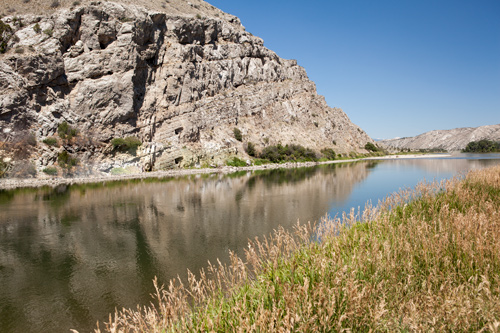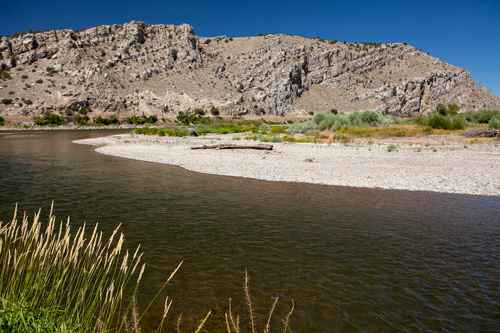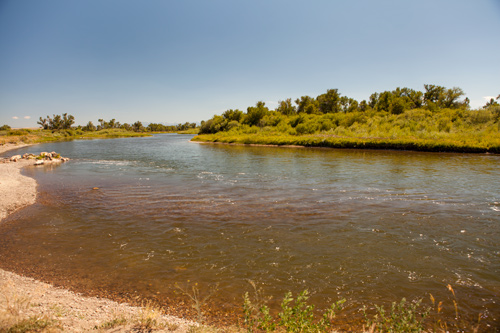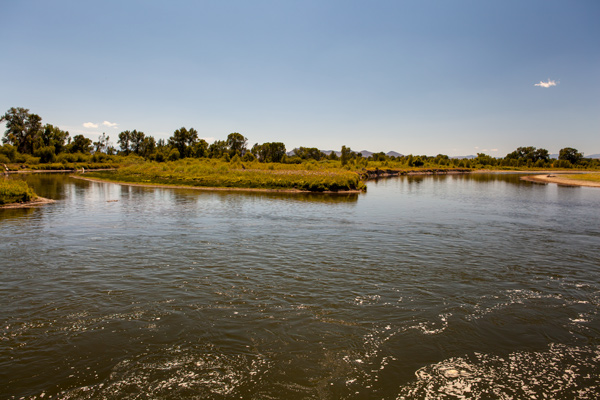Lewis and the boats reach the end of the Missouri River and Lewis decides to stay in the area to make celestial observations and rest the men. After exploring the Madison River, Clark’s small group returns to the headwaters, and the captains name the three forks: Jefferson, Madison, and Gallatin.
Lewis Arrives at the Three Forks
by Yellowstone Public Radio[1]Originally aired weekdays by Yellowstone Public Radio during the Bicentennial observance of 2003-2006. Narrated by Hal Hansen. Scripts by Whit Hansen and Ed Jacobson. Produced by Leni Holliman. © … Continue reading
Lodgepole Limestones
Below the Gallatin River mouth, 23 July 2013. © by Kristopher K. Townsend. Permission to use granted under the Creative Commons Attribution-Share Alike 4.0 International license.
Men Tire Quickly
We set out at an early hour and proceeded on but slowly the current still so rapid that the men are in a continual state of their utmost exertion to get on, and they begin to weaken fast from this continual state of violent exertion.
—Meriwether Lewis
Bighorn Sheep
the river was again closely hemned in by high Clifts of a solid limestone rock which appear to have tumbled or sunk in the same manner of those discribed yesterday. the limestone appears to be of an excellent quality of deep blue colour when fractured and of a light led colour where exposed to the weather. it appears to be of a very fine gr[a]in the fracture like that of marble. we saw a great number of the bighor [Bighorn Sheep] on those Clifts.
—Meriwether Lewis
Latitude and Longitude
beleiving this to be an essential point in the geography of this western part of the Continent I determined to remain at all events untill I obtained the necessary data for fixing it’s latitude Longitude &c.
—Meriwether Lewis
Rush’s Pills
at 3 P. M. Capt clark arrived very sick with a high fever on him and much fatiegued and exhausted . . . . Capt. C. thought himself somewhat bilious and had not had a passage for several days; I prevailed on him to take a doze of Rushes pills, which I have always found sovereign in such cases and to bath his feet in warm water and rest himself.
—Meriwether Lewis
Worries about Horses
we begin to feel considerable anxiety with rispect to the Snake Indians. if we do not find them or some other nation who have horses I fear the successfull issue of our voyage will be very doubtfull or at all events much more difficult in it’s accomplishment . . . . however I still hope for the best, and intend taking a tramp myself in a few days to find these yellow gentlemen if possible.
—Meriwether Lewis
Mouth of the Gallatin
© 23 July 2013 by Kristopher K. Townsend. Permission to use granted under the Creative Commons Attribution-Share Alike 4.0 International license.
Naming the Gallatin
1 ¼ to the upper point of a high clift of rocks in a Stard. opposite or a little below the entrance of the S. E. fork of the Missouri which we called Gallitin’s river in honor of Albert Gallitin [Albert Gallatin] Secretary of the Treasury
—Meriwether Lewis
Naming the Madison
½ to the confluence of the middle and S. W. forks of the Missouri each 90 yds. wide; the Middle fork we called Maddison’s river in honor of James Maddison the Secretary ofState.—
—Meriwether Lewis
Naming the Jefferson
the S. W. fork we called Jefferson’s River in honor that illustratious peronage Thomas Jefferson President of the United States.
—Meriwether Lewis
Mouth of the Madison
© 23 July 2013 by Kristopher K. Townsend. Permission to use granted under the Creative Commons Attribution-Share Alike 4.0 International license.
Jefferson-Madison Confluence
© 23 July 2013 by Kristopher K. Townsend. Permission to use granted under the Creative Commons Attribution-Share Alike 4.0 International license.
In the above photo, the Jefferson River is flowing towards the camera, and the Madison is flowing from left to right.
Weather Diary
State of the thermometer at rise
Weather at rise
Wind at rise
State of the Thermometer at 4 P.M. Weather at 4 P.M. Wind at 4 P.M. State of the river 52 [above 0] cloudy S W 80 [above 0] cloudy after rain S. W. fallen ½ in. a considerable fall of rain unattended with Lightning. Capt Clark rejoins me. [Clark:] I join the party at the 3 forks verry Sick.
—Meriwether Lewis and William Clark[2]To assist the reader, the editor of this web page has omitted the date column, merged the “State of the river” columns, and spelled out some abbreviations.
Three Forks of the Missouri is a High Potential Historic Site along the Lewis and Clark National Historic Trail managed by the U.S. National Park Service. The site a Montana State Park.
Notes
| ↑1 | Originally aired weekdays by Yellowstone Public Radio during the Bicentennial observance of 2003-2006. Narrated by Hal Hansen. Scripts by Whit Hansen and Ed Jacobson. Produced by Leni Holliman. © 2003 by Yellowstone Public Radio. |
|---|---|
| ↑2 | To assist the reader, the editor of this web page has omitted the date column, merged the “State of the river” columns, and spelled out some abbreviations. |






